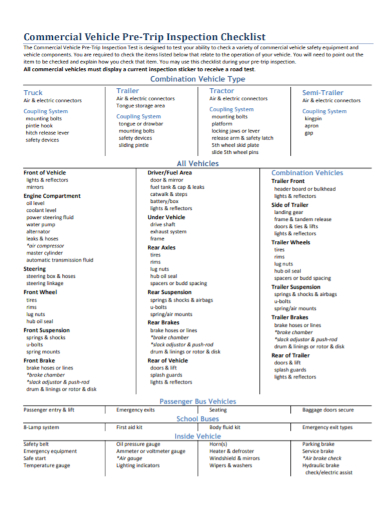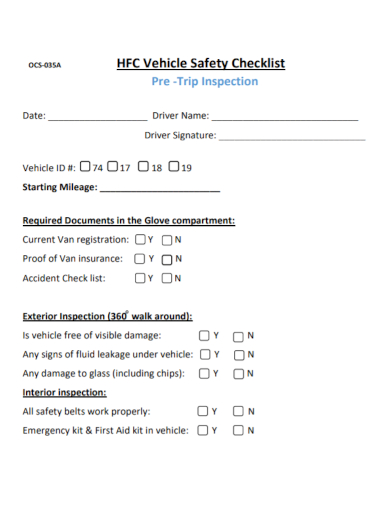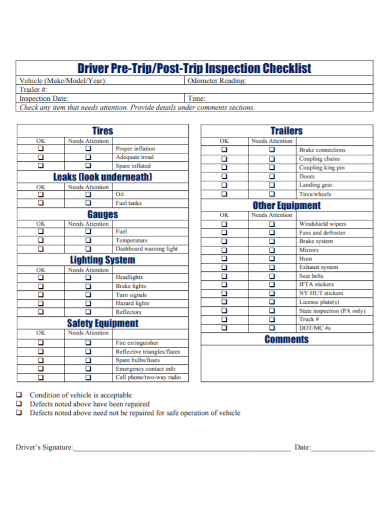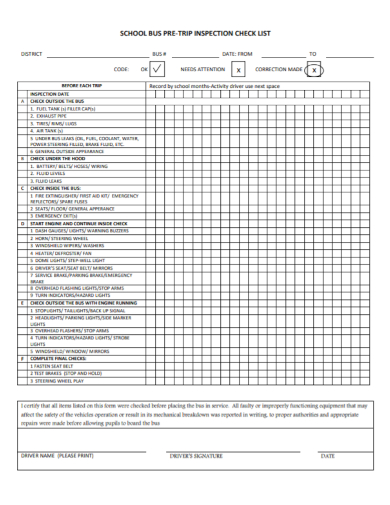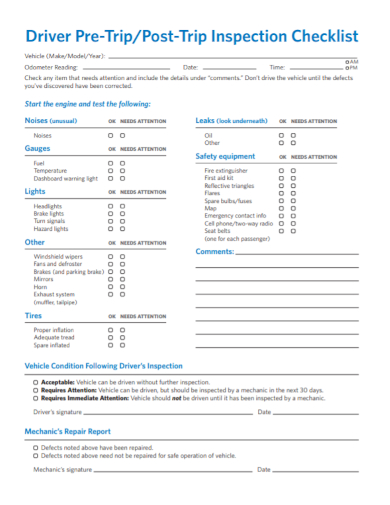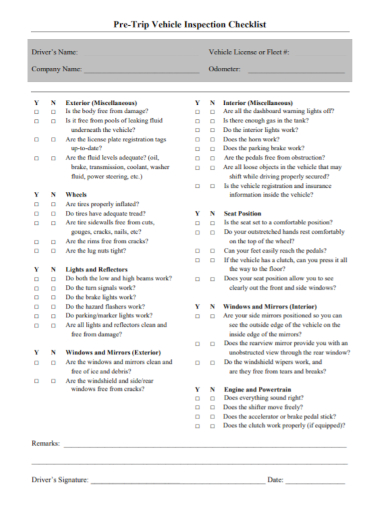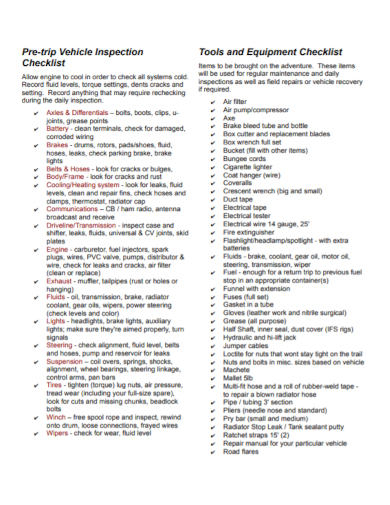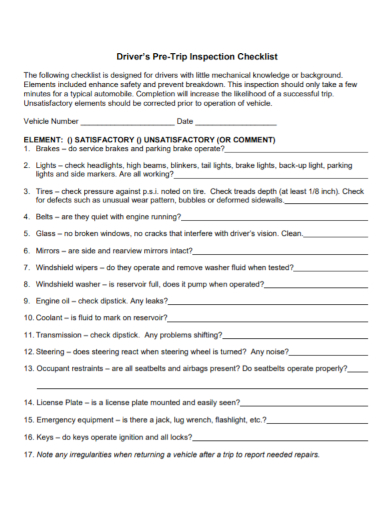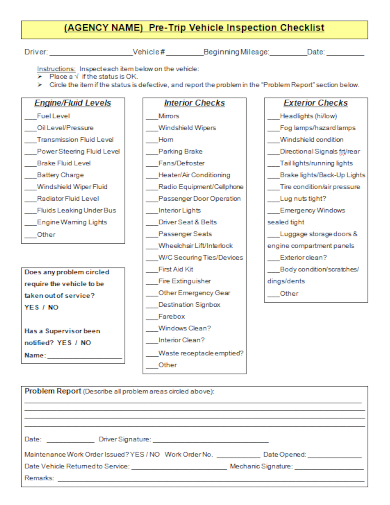Whenever we want to take a vacation with a long drive across the country side one of the first thing you have to prepare is getting your vehicle all prepped up. You don’t want to end up getting stuck in the middle of nowhere ruining your vacation altogether. A vehicle inspection could be done by you or any professional with a help of Trip Vehicle Inspection Checklist. To know more about this continue reading this article and don’t forget to check our free Trip Vehicle Inspection Checklist Samples below:
9+ Trip Vehicle Inspection Checklist Samples
1. Commercial Vehicle Pre-Trip Inspection Checklist
2. Pre-Trip Vehicle Inspection Checklist
3. Pre-Trip Vehicle Safety Checklist Inspection
4. Driver Pre-Trip Vehicle Inspection Checklist
5. School Bus Pre-Trip Inspection Checklist
6. Driver Post-Trip Vehicle Inspection Checklist
7. Sample Pre-Trip Vehicle Inspection Checklist
8. Trip Vehicle Equipment Inspection Checklist
9. Sample Driver Pre-Trip Vehicle Inspection Checklist
10. Agency Pre-Trip Vehicle Inspection Checklist
What Is a Trip Vehicle Inspection Checklist?
While a Trip Vehicle Inspection is highly encouraged for any driver who plans to go on a long drive, this is actually a mandatory procedure done by trucking companies, bus operators, car rentals or any business that has a fleet of vehicles for rental or commercial use. With the help of a Trip Vehicle Inspection Checklist drivers perform a thorough check of his or her vehicle, making sure each part is working as required. The purpose of these daily vehicle inspections is to identify and report any defects on your commercial vehicle, and to help take vehicles with safety concerns.
How to Create a Trip Vehicle Inspection Checklist?
There are different kinds of vehicles out there which means some of its functionalities and equipment may differ. These could be heavy vehicles, a car, or a bus. Regardless of what type of vehicle, performing an inspection a preventive measure to ensure the safety of the driver, passengers and for fleet drivers this would ensure that the goods you are transporting arrives securely. With this being said, let us tackle some key points as you create a trip vehicle inspection checklist.
1. Basic Information
For recording and reference purposes, your checklist must include the vehicle model, number and the driver’s details.
2. Vehicle Exterior
- Tires should be inspected for proper inflation and tread. Drivers should check for acceptable tire PSI and monitor tire tread depth to ensure proper traction on the road, most especially if the trip would entail crossing through rough terrain.
- Identify any general vehicle damage or deterioration.
- Check the fuel tank for any leaks and make sure that all is secure.
- Inspect the headlights, lamps and reflectors if all are working.
- Check the vehicle body and mirrors for dents, scratches, or other issues.
- If this is a heavy vehicle use for transporting, ensure that the cargo compartment would open and close securely.
3. Vehicle Interior
- Check the Odometer reading as this is considered an essential data points in fleet management. Keeping a record of the mileage not only keeps your drivers compliant, but it can also help you manage part replacement and servicing.
- Check if the vehicle’s horn, heater and air-conditioning are operating correctly.
- Ensure that there are no loose wirings, doors can open and shut properly, seatbelts and emergency equipment and safety devices are accessible and undamaged.
- Inspect the areas around the vehicle’s battery such as the battery mounting, terminals and cables to avoid any failures throughout a driver’s trip.
- Examine the engine compartment such as the hoses and tubing, as well as any fluid reservoirs, for any obvious or potential leaks.
4. Vehicle Controls
- Brakes: Some vehicles such as trucks and heavy vehicles may have multiple brake system. Every component of the brake systems should be checked daily for the condition. Hydraulic, air and parking brakes should be tested manually.
- Vehicle controls including the accelerator, clutch, gauges, and indicators should be functioning properly.
- Steering wheel along with the window wipers should be operating properly.
FAQs
What Is a Vehicle Inspection Report?
This is a type of report submitted by a contractor or a licensed dealer or repairer authorized by the commissioner to conduct emissions inspections, which, when validated by a pass or fail mark constitutes proof of inspection.
What Is a Fleet Vehicle?
A Fleet Vehicle is a motor vehicle that is owned or leased by a business and is often used by employees in the performance of their job duties. Examples of which are trucks, heavy vehicles or buses.
What Is a Mechanic?
A Mechanic is responsible for inspecting vehicle engine and mechanical/electrical components in order to diagnose issues accurately. They also monitor inventory, assemble mechanical components, and perform repairs.
Inspections are precautionary measures that be very important in road safety management. Finding and addressing problems with proper trip inspections can help drivers avoid costly road violations that can lead to high fines. Catching potential safety issues early can also help reduce the length and frequency your vehicle is out of service for repairs. Lastly it can help prevent road or traffic accidents due to a malfunctioning vehicle.
Related Posts
FREE 17+ Survey Checklist Samples in MS Word | Google Docs | PDF
FREE 18+ Background Checklist Samples in MS Word | Google Sheets | PDF
FREE 18+ Facilitator Checklist Samples in MS Word | Google Sheets | PDF
FREE 18+ Complaint Checklist Samples in MS Word | Google Sheets | PDF
FREE 18+ Internship Checklist Samples in MS Word | Google Docs | PDF
FREE 18+ Statement Checklist Samples in MS Word | Google Sheets | PDF
FREE 20+ Voluntary Checklist Samples in MS Word | Google Sheets | PDF
FREE 18+ Summary Checklist Samples in MS Word | Google Sheets | PDF
FREE 14+ Sponsorship Checklist Samples in MS Word | MS Excel | PDF
FREE 18+ Conference Checklist Samples in MS Word | Google Sheets | PDF
FREE 17+ Lesson Checklist Samples in MS Word | Google Sheets | PDF
FREE 18+ Progress Checklist Samples in MS Word | Google Docs | PDF
FREE 18+ Enrollment Checklist Samples in MS Word | Google Docs | PDF
FREE 18+ Graduation Checklist Samples in MS Word | Google Sheets | PDF
FREE 15+ Consent Checklist Samples in MS Word | Google Sheets | PDF

